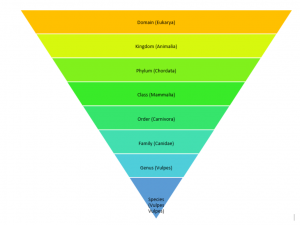18.1: Specificity Taxonomy
- Page ID
- 50442
\( \newcommand{\vecs}[1]{\overset { \scriptstyle \rightharpoonup} {\mathbf{#1}} } \)
\( \newcommand{\vecd}[1]{\overset{-\!-\!\rightharpoonup}{\vphantom{a}\smash {#1}}} \)
\( \newcommand{\id}{\mathrm{id}}\) \( \newcommand{\Span}{\mathrm{span}}\)
( \newcommand{\kernel}{\mathrm{null}\,}\) \( \newcommand{\range}{\mathrm{range}\,}\)
\( \newcommand{\RealPart}{\mathrm{Re}}\) \( \newcommand{\ImaginaryPart}{\mathrm{Im}}\)
\( \newcommand{\Argument}{\mathrm{Arg}}\) \( \newcommand{\norm}[1]{\| #1 \|}\)
\( \newcommand{\inner}[2]{\langle #1, #2 \rangle}\)
\( \newcommand{\Span}{\mathrm{span}}\)
\( \newcommand{\id}{\mathrm{id}}\)
\( \newcommand{\Span}{\mathrm{span}}\)
\( \newcommand{\kernel}{\mathrm{null}\,}\)
\( \newcommand{\range}{\mathrm{range}\,}\)
\( \newcommand{\RealPart}{\mathrm{Re}}\)
\( \newcommand{\ImaginaryPart}{\mathrm{Im}}\)
\( \newcommand{\Argument}{\mathrm{Arg}}\)
\( \newcommand{\norm}[1]{\| #1 \|}\)
\( \newcommand{\inner}[2]{\langle #1, #2 \rangle}\)
\( \newcommand{\Span}{\mathrm{span}}\) \( \newcommand{\AA}{\unicode[.8,0]{x212B}}\)
\( \newcommand{\vectorA}[1]{\vec{#1}} % arrow\)
\( \newcommand{\vectorAt}[1]{\vec{\text{#1}}} % arrow\)
\( \newcommand{\vectorB}[1]{\overset { \scriptstyle \rightharpoonup} {\mathbf{#1}} } \)
\( \newcommand{\vectorC}[1]{\textbf{#1}} \)
\( \newcommand{\vectorD}[1]{\overrightarrow{#1}} \)
\( \newcommand{\vectorDt}[1]{\overrightarrow{\text{#1}}} \)
\( \newcommand{\vectE}[1]{\overset{-\!-\!\rightharpoonup}{\vphantom{a}\smash{\mathbf {#1}}}} \)
\( \newcommand{\vecs}[1]{\overset { \scriptstyle \rightharpoonup} {\mathbf{#1}} } \)
\( \newcommand{\vecd}[1]{\overset{-\!-\!\rightharpoonup}{\vphantom{a}\smash {#1}}} \)
Good description lives and dies in particularities. It takes deliberate effort to refine our general ideas and memories into more focused, specific language that the reader can identify with.

A taxonomy is a system of classification that arranges a variety of items into an order that makes sense to someone. You might remember from your biology class the ranking taxonomy based on Carl Linnaeus’ classifications, pictured here.

Gustav Freytag is credited with this particular model, often referred to as “Freytag’s pyramid.” Freytag studied the works of Shakespeare and a collection of Greek tragic plays to develop this model in Die Technik des Dramas (1863).
To practice shifting from general to specific, fill in the blanks in the taxonomy below. After you have filled in the blanks, use the bottom three rows to make your own. As you work, notice how attention to detail, even on the scale of an individual word, builds a more tangible image.
| More General | General | Specific | More Specific | |
| Example | Animal | Mammal | Dog | Great Dane |
| 1a | Organism | . | Conifer | Douglas Fir |
| 1b | Airplane | Boeing 757 | ||
| 2a | Novel | Harry Potter and the Goblet of Fire | ||
| 2b | Clothing | Blue Jeans | ||
| 3a | Medical Condition | Respiratory Infection | ||
| 3b | School | College | ||
| 4a | Artist | Pop Singer | ||
| 4b | Structure | Building | White House | |
| 5a | Coffee | Starbucks Coffee | ||
| 5b | Scientist | Sir Isaac Newton | ||
| 6a | ||||
| 6b | ||||
| 6c |
Compare your answers with a classmate. What similarities do you share with other students? What differences? Why do you think this is the case? How can you apply this thinking to your own writing?


